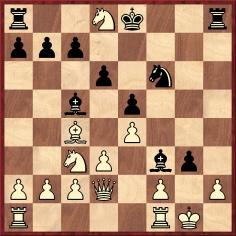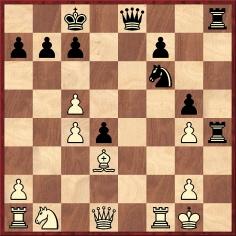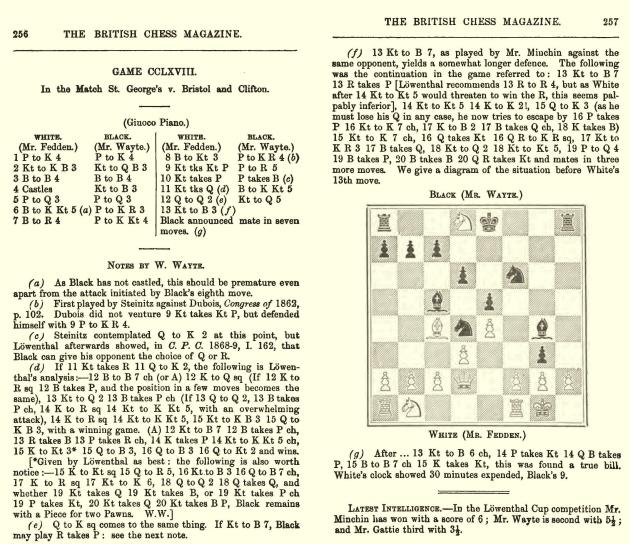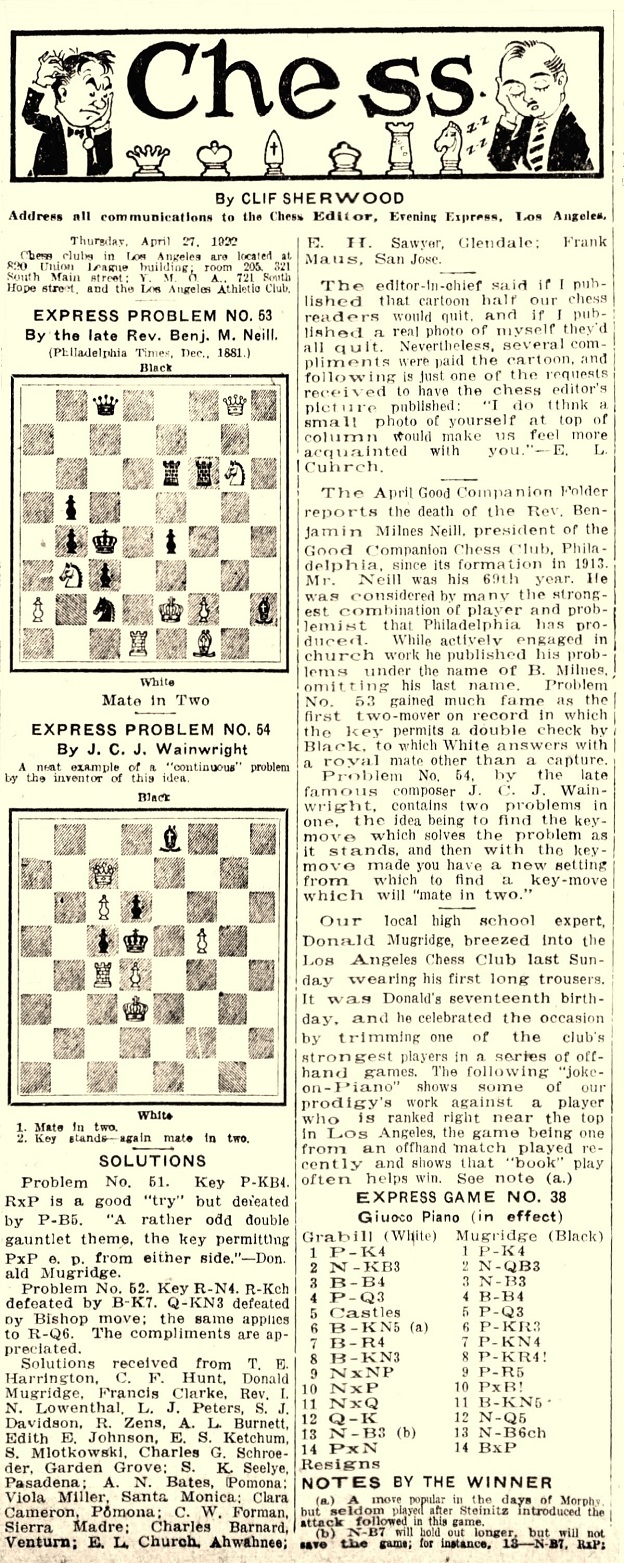
Edward Winter

Leon Rosen (American Chess Bulletin, June 1909, page 130)
From page 131 of the June 1909 American Chess Bulletin:
H. Menkes – Leon Rosen
Rice Club Championship, New York, 1909
Two Knights’ Defence
1 e4 e5 2 Nf3 Nc6 3 Bc4 Nf6 4 d3 Bc5 5 O-O d6 6 Bg5 h6 7 Bh4 g5 8 Bg3 h5 9 Nxg5 h4 10 Nxf7

10...hxg3 11 Nxd8 Bg4 12 Qd2 Nd4 [An endnote on page 269 of Chess Explorations mentioned that a correspondence game between C.S. Ashley and A.H. Tollit published on page 285 of the August 1923 BCM went 13 h3 Ne2+ 14 Kh1 Rxh3+ 15 gxh3 Bf3 mate.] 13 Nc3 Nf3+ 14 gxf3 Bxf3 15 White resigns.

The magazine remarks:
‘The entire play is “book”, which fact, however, makes the game none the less interesting.’
For some reason these moves are also said to have been played in a game between Dubois and Steinitz, London, 1862 (e.g. pages 2-3 of Chess, More Miniature Games by J. du Mont), even though that game developed along altogether different lines after 9 h4 Bg4 10 c3 Qd7. It continued 11 d4 exd4 12 e5 dxe5 13 Bxe5 Nxe5 14 Nxe5 Qf5 15 Nxg4 hxg4 16 Bd3 Qd5 17 b4 O-O-O 18 c4 Qc6 19 bxc5 Rxh4 20 f3 Rdh8 21 fxg4 Qe8, etc.

On the other hand, the complete 14-move game above appears on page 114 of Chernev’s 1000 Best Short Games of Chess under the heading ‘Grabill v Mugridge, Los Angeles, 1932’ and with the statement that the win is based on a brilliant piece of analysis by Steinitz.
C.N. 1750 drew attention to the mystery, as yet unresolved, as to why the Dubois-Steinitz game in the London, 1862 tournament has often flown under the false colours of a miniature. An article by Bent Larsen on pages 28-30 of Inside Chess, 20 March 1989 prompts us to point out further discrepancies in the record of this famous game.
The weakness of Larsen’s article is twofold: a) he assumes that [in the third diagram above] White played 22 Qe1 (‘??’), whereas there is a far greater chance that Dubois’ move was 22 Qe2, as given in the tournament book. Secondly, taking 22 Qe1 to have been the move, Larsen is still guilty, as have been so many other commentators, of overlooking that, instead of 22...Qe3+, Black could force mate with 22...Rh1+ 23 Kf2 Rxf1+, etc. The longest variation is 24 Bxf1 Nxg4+ and mate in four.
This faster win in all variations was indicated by W.F. Streeter on page 33 of the American Chess Bulletin of February 1933. (He noted that 24 Bxf1 Nxg4+ won quickly, but missed the forced mate.)
On page 51 of the March 1933 American Chess Bulletin, Charles Devidé reacted as follows:
‘In No. 2., Vol 30, American Chess Bulletin Mr W.F. Streeter takes the late Richard Réti to task because of an exclamation point to Black’s 22nd move in the Dubois v Steinitz game played in the second international tournament at London in 1862. Since in my Steinitz Memorial Book I also employed that mark on that very occasion, I feel constrained to take up the cudgel not only in my own and the late Réti’s behalf, but also for Mr Löwenthal, the editor of the book of the London Tournament, 1862, for Herr Bachmann and the rest of the numerous annotators of the game in question, none of whom suggested the rook check, instead of 22...Q-K6ch. We did not do so for the good and sufficient reason that at this juncture Dubois’ queen stood at K2 and not at Ksq, as in Mr Streeter’s diagram of the position.
I may add that my Steinitz Memorial Book has a note to Black’s 21st move, Q(B3)-K, suggesting Kt-K5 as more expeditious.
Charles Devidé
P.S. White’s 22nd move was Q(Q)-K2. The S.M.B. says that by 22 B-B5ch, followed by 23 R-K, his game would have been defensible.’
To this Mr Streeter was given the opportunity to reply immediately below:
‘Regarding the Dubois v Steinitz position, which appeared in the Bulletin in February, Mr DeVide [sic] seems to be correct in his contention that White’s 22nd move was Q-K2. At least, the London Tournament Book of 1862 shows that to be the move. This would seem to clear the players of the charge of having overlooked a rather simple continuation, but does not absolve Réti, as he apparently was assuming that Q-K was the move played.’
Mr Streeter missed a trick by not pointing out that Bachmann’s collection of Steinitz’s games (volume one, page 16) also gave 22 Qel, as did page 282 of the September 1862 Deutsche Schachzeitung, but his criticism of Réti, which also applies to Larsen, is justified.
(1864)
It should, though, be borne in mind that Réti’s book was published posthumously: Die Meister des Schachbretts (Masters of the Chess Board).
See too Duplication of Chess Games.
As regards the 14-move miniature, attributed to various players from Steinitz onwards, we now note that on pages 186-187 of El Ajedrez Americano, June 1937, Roberto Grau stated that Capablanca had won the game (with the slight transposition 3 Bc4 Bc5 4 d3 Nf6). White was named as ‘N.N.’, no occasion was specified, and we believe that Grau was simply mistaken.
(2181)
Walter Korn discussed this topic on pages 382-383 of the November 1948 BCM, reporting that an identical miniature game which ended with 14...Bxf3 was Velasco v Zollner, Munich, 1935. After quoting a claim by Kurt Richter that the same game had also been played by Steinitz, Korn wrote:
‘All I could discover was an analysis by Steinitz and Löwenthal in 1869 to the game Dubois-Steinitz, London, 1862, which continued 9 P-KR4, with far tougher resistance by White; the same 1935 game was, however, played before between E.W. Grabill and D. Mugridge in Los Angeles on 20 April 1922, with 12 Q-K1 in place of 12 Q-Q2 as the only difference.’
Korn covered similar ground on pages 333 and 352 of the November 1963 Chess Review. In neither publication did he give sources, or mention the Menkes v Rosen game.
For our part, we offer a few observations:
A) Velasco v Zollner (played ‘in der Münchener Meisterschaft 1934/35’) was published on page 24 of the 15 January 1936 issue of Deutsche Schachblätter (a magazine edited by Richter).
B) We seek substantiation of Korn’s date for the Grabill v Mugridge game (‘20 April 1922’, whereas, as mentioned above, Chernev put ‘1932’). So far, we have not found the game-score in the American Chess Bulletin. Page 146 of the September-October 1922 issue had a photograph of participants in the Second California State Championship. Mugridge (‘Donald H. Mugridge, only 17 years of age’) and E.W. Grabill were at the same board, but the crosstable on the following page records that their game was a draw. The dates given for the tournament were 4-15 September.
C) Grabill and Mugridge participated in the double-round Los Angeles Chess Club championship of 1922, as shown by the crosstable on page 106 of that year’s May-June issue of the American Chess Bulletin. However, Mugridge scored only one draw against Grabill.
D) C.N. 1750 should have mentioned that whereas Menkes played 12 Qd2, Grabill’s move (according to Chernev and Korn) was 12 Qe1.
E) Regarding nineteenth-century analysis, we have found an article by Löwenthal, ‘The King’s Knight’s Opening’, on pages 161-165 of the April 1869 Chess Player’s Chronicle. The relevant section, on pages 163-164, stated that in the line 12 Qe1 (or Qd2) Nd4 13 Nc3 ‘Black can obviously force mate in a few moves’.
Olimpiu G. Urcan (Singapore) notes that the moves 1 e4 e5 2 Nf3 Nc6 3 Bc4 Bc5 4 O-O d6 5 d3 Nf6 6 Bg5 h6 7 Bh4 g5 8 Bg3 h5 9 Nxg5 h4 10 Nxf7 hxg3 11 Nxd8 Bg4 12 Qd2 Nd4 13 Nc3 Nf3+ 14 gxf3 Bxf3 ‘0-1’ were given on pages 197-198 of the 15/2007 Quarterly for Chess History as a game between V. Knorre and M. Chigorin in St Petersburg, 1874. The source provided by Vlastimil Fiala was ‘Shakhmatnyj Listok, 1877, pp. 59-60’.
We add that Walter Korn mentioned Chigorin in the article on page 352 of the November 1963 Chess Review, immediately after his reference to Grabill v Mugridge and Velasco v Zollner: ‘... Chigorin is purported to have won several such games against Knorre in 1900 or 1902’.
From Eduardo Bauzá Mercére (New York, NY, USA) comes an addition to (a game between Fedden and Wayte published in the BCM, June 1884, pages 256-257):

(8596)
Concerning Dubois v Steinitz, see too pages 42-44 of Questions of Modern Chess Theory by Isaac Lipnitsky (Glasgow, 2008).
Noting the discrepancies over the occasion of the well-known Grabill v Mugridge brilliancy (1 e4 e5 2 Nf3 Nc6 3 Bc4 Nf6 4 d3 Bc5 5 O-O d6 6 Bg5 h6 7 Bh4 g5 8 Bg3 h5 9 Nxg5 h4 10 Nxf7 hxg3 11 Nxd8 Bg4 12 Qe1 Nd4 13 Nc3 Nf3+ 14 gxf3 Bxf3 15 White resigns), Eduardo Bauzá Mercére has sent us the game’s appearance, with brief notes by the winner, on page 19 of the Los Angeles Evening Express, 27 April 1922, in the chess column of Clif Sherwood:


(11964)
To the Chess Notes main page.
To the Archives for other feature articles.
Copyright: Edward Winter. All rights reserved.